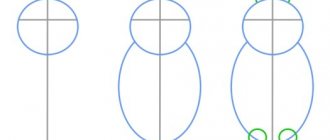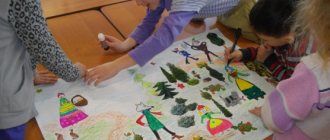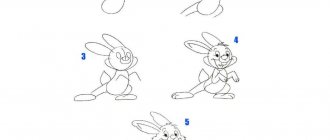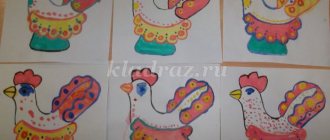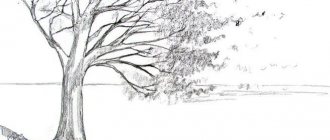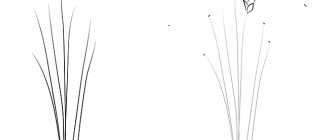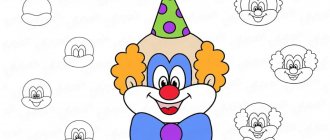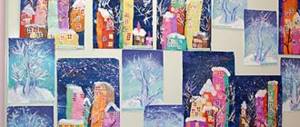Notes on drawing "My favorite toy" in the preparatory group
Olga Osmanova
Notes on drawing "My favorite toy" in the preparatory group
Objectives: introduce children to toys and their history , consolidate knowledge about toys . Develop imagination, memory, attention, accuracy. Learn the ability to draw and paint over a picture, correctly observe the proportions of an object, and arrange it beautifully on a sheet of paper. Cultivate interest in artistic creativity.
Material: Toys (car, doll, tumbler, airplane, color illustrations, pencil, colored pencils, eraser, landscape sheet, oilcloth.
Preliminary work: Reading A. Barto “ Toys ”
, Y. Taits
“Cube upon cube”
, V. Shipunova
“Ball”
, L. Tolstoy
“Nastya had a doll”
, E. Shalamonova, didactic games:
“Cut pictures”
,
“Wonderful bag”
,
“Assemble a beautiful pyramid”
,
“Which
toy is gone ” ,
“Domino”
DRAWING from life “My favorite bear”
⇐ PreviousPage 25 of 26Next ⇒Tasks. Continue teaching children to draw toys from life. Introduce the sketch as a stage of work planning (create a contour drawing with pencil or charcoal), convey color and texture using any materials of your choice. To develop the ability to convey in a drawing one’s attitude towards what is depicted.
Preliminary work. Reading the story “Childhood Friend” by V. Dragunsky. Drawing toys from life optional (in the older group). The day before, the teacher asks the children to bring their favorite bear to kindergarten.
Materials, tools, equipment. White and tinted paper of various sizes, simple pencils (charcoal), pastels, gouache paints, brushes, colored pencils, jars of water, palettes, salo
845
mats, a wooden or plastic frame without a backdrop for displaying and explaining the composition options (the size of the frame is selected according to the size of the toy), 3-5 different bears.
Contents of the lesson. Before class, the teacher asks the children to place their bears that they brought from home on the tables. For those children who do not have such a toy or who forget to bring them, the teacher prepares several different bears.
Then he invites the children to draw portraits of their childhood friends.
The teacher takes one bear in his hands, shows it to the children in different positions - standing on two legs, sitting in front, profile, lying, etc. Asks the children which sheet of paper and how to position it in each specific case (horizontally or vertically) . The teacher shows the children options for creating compositions: lifts up the frame from the picture (without a backdrop), holds the toy behind it and places it so that first only one head and part of the body are visible, and then the entire toy. He explains that the portrait can depict both the entire toy and its part - the head. Invites 2-3 children in turn and asks them to “frame” (place in a frame) portraits of a sleeping, sitting and standing bear. The teacher asks how one can convey in a portrait that this is a favorite toy. (Show that the bear is smiling, looking into our eyes, draw a frame with a heart, etc.) Then he asks how he can convey the fluffiness or raggedness of the bear’s “fur coat.” (Draw by dipping the bristles of a brush, with a cotton swab or with pencil strokes along the contour line.) Reminds children of what a sketch is (a quick sketch with a simple pencil or charcoal) and offers to choose materials for a portrait as they wish.
Children choose the size, format and color of the paper, measuring it with the size of their toy (apply it, examine it), place the bear in the intended position and begin to draw a portrait. If the children find it difficult to start working, the teacher shows with chalk on the board how the sketch is created. At the top of the sheet there is an oval or circle of the head, below there is a larger body and options for placing the paws, he advises choosing the color of art materials according to the color of the bear, and if necessary, composing a color or shade on the palette.
At the end of the lesson, an exhibition of works “MY FAVORITE BEAR” is held. Children can sign their bear's name.
After class. The teacher can conduct individual work on composing descriptive stories on the topic “My favorite bear.” In an independent art activity, children can frame portraits.
846
KNOWING THE WORLD AROUND
"Etiquette"
Tasks. Cultivate a respectful attitude towards other people, especially the elderly, and develop skills of polite behavior in different situations.
Material. Pictures-conventional signs depicting the rules of behavior in public transport (for example, a conventional image of a disabled person or an elderly person with a cane, a small child sitting on an adult’s lap, etc.). Stuffed Toys.
Contents of the lesson. The teacher invites the children to listen to a poem about how “a bear of five or six years old was taught how to behave.” He reads an excerpt from S. Ya. Marshak’s poem “A Lesson in Politeness,” starting with the words: “A bear of five or six years old / Was taught how to behave” and to the words: “But, apparently, the teachers / Wasted their time!”
The teacher discusses with the children what it means to be polite (polite is the one who is in charge, that is, knows how to behave, and the ignorant is the one who knows nothing), how a polite person should behave, what this bear of five or six years old did right and wrong, why his behavior was called “bearish” and the teachers wasted their time raising him.
Then the teacher invites the children to listen to another poem by S. Ya. Marshak, which is called “If you are polite” and reads out passages: the first passage begins with the words: “If you / Are polite / And to your conscience / Are not deaf” and ends with the words: “In trolleybus / You will help / Climb / a disabled person”; the second passage begins with the words: “And if you / Are polite, / Help / You mother” and ends with the words: “Then in a conversation with your aunt, / And with your grandfather, / And with your grandmother, / You will not interrupt them.
The teacher remembers and discusses with the children how a polite person should behave: give up a seat on transport to the elderly and disabled, help their mother, and not interrupt adults. The teacher shows the children pictures-conventional signs depicting the rules of behavior in public transport, examines them with the children and discusses what they mean (for example: a conventional image of a disabled person or an elderly person with a stick - places for the elderly and disabled; a small child sitting on his lap for an adult, there are seats for passengers with children, etc.). The teacher, together with the children, formulates the rules of behavior.
Then the teacher invites the children to role-play different situations using soft toys and show how a well-mannered person should behave. For example, if you accidentally pushed someone,
847
I need to apologize; if you want to take something, you need to ask permission, and then thank, etc.
In conclusion, the teacher discusses with the children:
- what does it mean to “be obedient”, who should you obey;
— why adults know more than children;
- why children sometimes don’t listen to adults, what can happen if you don’t listen to adults;
- what would happen if adults had to obey children, and not vice versa;
- about whom they say that he “behaves badly”;
- what behavior the child likes, but the adult does not like, what behavior the adults like, but the child does not like, what behavior no one likes, what behavior everyone likes.
After class. The teacher can tell the children about ancient etiquette: rules of behavior at the table, polite formulas (“Dear sir, I humbly forgive me for bothering you, would you please pass me the bread”), curtsies and shuffling of the foot, i.e., about such rules that not anymore. One day during lunch, he may offer to behave according to the old rules - in the form of a game.
DESIGN flat made of paper “Bear Circus”1
Tasks. Learn to complete and transform the “background” picture; see concrete objects of reality in geometric figures; construct from them images of spectators in the circus and performers in the arena during the performance of the act; convey the features of their structure and the relationship of parts in size and proportions; combine figures into a collective plot composition using adequate visual and compositional means (front view, side view, rear view, next to it, right view, below view, etc.).
Preliminary work. Reading children's fiction about the circus: performers and trained animals; rules of conduct for spectators during the performance; looking at illustrations.
Materials, tools, equipment. Illustrations on the theme "Circus". A background picture on a rolled sheet of paper for constructing a collective composition, conveying a conventional image of a round circus arena; two or three rows of seats for spectators (straight view, behind the arena). Colored paper, scissors, glue stick, simple
Abstract prepared by G. V. Uradovskikh.
pencil and markers; paper parts: ovals (2x4, 2x6, 2x8, 4x6, 4x8, 6x10), circles (2x2, 4x4, 6x6, 8x8), squares and circles (4×4, 8×8), rectangles (2×4, 2×6, 2×8, 4×6, 4×8, 6×10) 10-12 pieces of two or three colors for each child . (Parts of this size are suitable for a background composition of 2 sheets of whatman paper; the smaller the size of the background sheet, the smaller the details should be.)
This work can be done using parts of the Tangram game; in this case, children only lay out the images, but do not glue them.
Contents of the lesson. The teacher draws the children's attention to illustrations of circus performances and invites them to look at them. He asks: do they like going to the circus; how the circus works; what is the main place in the circus (arena); what shape is the circus arena (round); where the seats for spectators are located (around the arena); the performances of which artists they saw in the circus (funny clowns, dexterous jugglers, strong acrobats and gymnasts, fearless trainers, mysterious magicians); were there any trained animals (lions, tigers, bears, elephants, seals, dogs, birds); what numbers they performed; whether they saw performances of trained bears. He remembers with the children that some of them dance, others, lying on their backs, spin a log with their paws. The teacher supplements the children’s memories with fictitious numbers and asks them to imagine how cub gymnasts can perform in the arena. One, for example, is holding a long pole, with a bear cub balancing on a small platform at its upper end. He stands on one leg. Next to them, on the mat, strength gymnasts perform an exercise. At this time, aerialists perform a routine under the circus dome. One of them holds on to the crossbar with his hind legs and catches the other, who “flies” towards him with his paws stretched forward. He emphasizes that in a real circus bears do not yet perform such acts.
The teacher creates a desire to depict this performance and construct a picture of their performance in the circus. He shows the children a background picture and says that this is a circus arena, and here are seats for spectators.
Before starting work, the teacher asks the children to think about what their teddy bear will do and helps distribute the amount of work between the children, taking into account their wishes. Some children can construct images of figures of artists, others - of spectators (children, adults). The teacher explains that first the children will collect their figures on separate sheets of paper, and then transfer them to the background picture, find a certain place for them and glue them.
After this, the children design while sitting at the tables. Depending on the object being designed, parts of a certain color, shape, size are selected and constructed, testing different options for its layout.
54 Order 1583
849
skeletal image (angle, dynamics, color scheme, taking into account the relationships between the sizes of parts of a figure, etc.). The teacher teaches how to convey different movements and different ways of performing one movement. For example, a bear cub is holding something, balancing, “flying,” turning, raising its head up, swinging its paws, pushing off with its legs, or juggling balls in various ways.
To convey the movements of the front and hind legs of bears, children are asked to use two ovals, which allows them to depict the animals’ limbs in different states (bent at the joint, raised up, laid back or spread to the sides). Children work independently. The teacher, with guiding questions, helps them find the right solution - to “revive” the cubs - to convey the image of all the artists as participants in one circus act, taking into account their interaction. If the children find it difficult, the teacher can suggest looking at the illustrations again.
If a child has a need for parts that do not exist, the teacher offers to make them himself.
Each child, having completed the search for the optimal version of the image of his figurine, includes it in the overall composition.
With the children who are responsible for depicting the audience (children and adults clapping, throwing flowers), the teacher discusses the methods of depiction and suggests using felt-tip pens to “complete” the image. He shows how to draw eyes, mouth, nose, hair, and clothing elements (collar, buttons, bow) in different ways.
In the final part of the lesson, the teacher praises all the children and asks them to look at the resulting picture.
NATURE
"Where the Kangaroo Lives"
Tasks. To acquaint children with the peculiarities of the nature of Australia, to form ideas about the diversity of the flora and fauna of the planet, that different animals and plants live on different continents.
Preliminary work. When organizing observations in a corner of nature, the teacher pays special attention to budgies: their coloring, appearance, the sounds they make, and behavioral characteristics. If possible, children watch fragments of videos about Australia, about the underwater world of the Great Coral Reef, or look at relevant illustrations in magazines and encyclopedias.
Materials, tools, equipment. Geographic map of the world, globe, children's geographical atlas, for example, “The World Around Us”, “The World and Man”; photographs, drawings of animals (koala, kangaroo, ostrich, platypus, cassowary or emu); plants (eucalyptus, breadfruit) of Australia, a dried twig or a drawing of a yellow mimosa; coat of arms of Australia (Union of Australia), small bag with a toy kangaroo.
Contents of the lesson. The teacher clarifies what time of year it is now and asks: “Could it be autumn somewhere on Earth now?” - and explains that there are such places on Earth. One of them is Australia. This is an amazing place. Many animals and plants in Australia are unusual. The teacher shows Australia on the globe: it is located not far from Antarctica, which the children have already studied. The teacher explains that in places that are located closer to the south pole, everything happens the other way around: when we have spring, there is autumn, when we have winter (autumn, summer), there...
The teacher suggests looking at a geophysical map (globe) and drawing a conclusion whether Australia is far or close to their region. Children attach bright stickers, such as pieces of sticky paper, to the place on the globe where their region is located and to Australia. The teacher says: “Despite the fact that Australia is far away, we know quite a lot about it, for example, we are familiar with some of the animals and plants of this continent. Australia is very big. It has deserts, high mountains, seashores, and forests. (Children look at the map of Australia from the Atlas “World and Man” or a children's map of the world.)
The teacher places in front of the children a cage with a budgie, covered with a cloth, and asks them to guess from the description which one.
850
54*
851
the bird is in a cage. (At the same time, the coloring and features of a particular parrot, which the children know well, are described.) When the children guess, the teacher removes the fabric from the cage and gives the children a few minutes to communicate with the bird. Preschoolers remember the name of the homeland of this bird.
The teacher gives the children, one by one, a dried branch of yellow mimosa, which they smell and touch. The teacher asks what the name of this plant is and what holiday it reminds of. (Bouquets of mimosa are usually given to mothers on March 8.) The teacher explains that this plant grows in Australia and is called acacia there.
The teacher shows a bag with a small toy kangaroo peeking out of it and asks if the children know an animal that carries a baby in its own bag and jumps well. After the children’s answers, he puts a figurine or toy of a kangaroo on the table and tells them that there are no such animals anywhere else in the world. Kangaroos come in big and small. Many of them are excellent jumpers on the ground, but there are also tree kangaroos that are excellent tree climbers. First, the baby kangaroo sits in a sack on its mother's stomach. When he grows up, he can jump out of it for a while and walk around, but then returns to his pouch again. Eventually the day comes when the fully grown kangaroo leaves its mother's pouch to move around on its own.
The teacher says that in Australia, many animals carry their babies in bags: marsupial mole, marsupial wolf, marsupial squirrel. (If possible, children look at illustrations of these animals.) Nowhere else in the world are there animals with bags for babies. Kangaroos eat different plants. One of them is called kangaroo grass. The teacher shows the emblem of Australia and asks what animals are depicted on it. (Kangaroo and ostrich.) Children are already familiar with kangaroos. What bird is depicted on the coat of arms? (Ostrich.) The teacher can show for comparison the coat of arms of any other region on which animals are depicted.
The teacher shows illustrations of Australian ostriches (this could be a cassowary or emu) and asks the children why, in their opinion, these birds are unusual. Children pay attention to the ostrich’s high, strong legs and short, small wings, express their opinion about what the ostrich can do better: run or fly, and explain their point of view.
The teacher shows a picture of a black swan, asks which of the children have seen this beautiful bird in the cities, and says that the homeland of black swans is Australia. They were brought to other places to decorate lakes and ponds.
The teacher asks the children to close their eyes, take turns sniffing the dry leaves and guess what tree they come from. So that the children
852
it was easier to do, the teacher reminds that a decoction of these leaves is often used to gargle for colds. Children open their eyes and examine the eucalyptus leaves, rub them in their hands, and smell them. The teacher puts a drawing of a eucalyptus on the table and says that it is a very tall tree. It drinks a lot of water. Few people like the taste of eucalyptus leaves, but there is an animal for which they are the main and only food.
The teacher asks the children if they know an unusual bear with large ears and a nose that is bent like a hook. This bear spends a lot of time in trees. The teacher puts a photo of a koala bear on the table and says that a koala is often called a big teddy bear. This animal sits motionless on a tree during the day, clasping the trunk with its paws. Koalas eat only eucalyptus leaves, and they eat at night. The teacher says that these animals were hunted because of their beautiful skin. In addition, people cut down eucalyptus trees, and koalas began to run out of food. There were fewer and fewer Australian bears, so they were listed in the Red Book. This book contains animals and plants, of which there are few left on Earth, and which need human help.
The teacher shows the children the front part of a card with a picture of a platypus (the back part of the picture is closed) and asks what animal could have such a “nose”. (In a duck. The nose of this animal is even sometimes called the “beak.”) Then he shows the tail of the platypus in the same way: which animal has a similar tail? (At the beaver.) The teacher opens the entire drawing and tells that an amazing animal lives in Australia - the platypus. It cannot be confused with any other animal. Why do the children think he was named that? The teacher once again pays attention to the platypus’s tail and the membranes on its front paws. Based on its appearance, children determine where this amazing animal lives - on land or in water. It hides in burrows and swims in lakes and streams. Thick dark brown fur protects it from wetness and extreme cold. It eats worms, larvae, mollusks, and tadpoles. The most amazing thing is that the platypus lays eggs. These animals are very rare, and that is why people protect them.
The teacher lets the children look at the corals and recalls with them the material covered about corals. Then he shows on the map the seas that wash the coast of Australia, and indicates the place where the Great Coral Reef is located. This is the most famous “coral” place in the world, home to a huge number of different corals, fish and other marine animals. If there are corals in the kindergarten, the teacher assumes that the coral that the children are holding in their hands can be brought from this place, and shows illustrations of the underwater world of a coral reef.
853
The teacher says that in Australia there are many not only unusual animals, but also plants. (The story is accompanied by a display of illustrations.) For example, a bottle tree, the thick trunk of which looks like a bottle. Such trees grow where it is very hot, so they store water in bottle trunks.
In conclusion, the teacher once again emphasizes that Australia is a very unusual place on Earth. Many of Australia's animals and plants live nowhere else in the world. Looking at the drawings, photographs, toys that were used in the lesson, children remember the animals and plants of Australia.
DEVELOPMENT OF SPEECH AND BEGINNING OF LITERACY “A funny bear cub lives in Australia”
Tasks. Involve children in meaningful cognitive communication - dialogue. Teach children to express their knowledge in the form of a short text; reason, give reasons for statements, ask questions and answer them. Enrich your vocabulary with figurative words and expressions. Operate with the printed word.
Material. Typesetting canvas. Board, chalk. Pictures and corresponding cards with the words: KOALA, KANGAROO, PARROT, CROCODILE. And also cards with the words: BEAR (2 pieces), LIVES, and LOVES, LEAVES, HE, ON, THE TREE, FUNNY, AND, KIND, • (dot - 4 pieces), - (dash).
Contents of the lesson. The teacher tells the children that they recently read a fairy tale about the toy bear Ushastik. And today they will get acquainted with a story about a real bear cub, who is also called Ushastik. He lives in distant Australia. Only in this country are marsupials found. He asks the children if they know what marsupials are and listens to their answers.
Tells the children that the bear cub they will meet in this story is also a marsupial. This baby lives in a pouch on his mother's stomach, and he is called a koala. Next, the teacher retells in his own words an excerpt from the book “Spring Leaves” (author L. Riis).
This little bear was named Ushastik because he has funny bushes of hair sticking out on his ears. He was born in the spring, when tender, sweet-smelling leaves appear on the trees.
Ushastik sat in the bag on his mother’s stomach all the time. He was already several months old when he dared to stick his head out of his mother's
bags. Sunlight streamed all around and everything around seemed golden, and far below was the earth, so far that the bear cub even felt dizzy.
Ushastik clung to his mother; her fur was thick and fluffy. The cub's fingers were well designed to hold on to her, clinging to her fur.
Ushastik was eager to do many things, but first of all, to taste those dark red leaves that glittered at the tips of the branches.
Soon Ushastik began to understand what a huge tree served as a refuge for them.
Ushastik soon realized that there was no better country for koalas than his homeland, a land covered with dense eucalyptus forests.
The teacher shows the children a picture (or toy) of a koala and asks questions:
— Why was the bear cub called Ushastik?
- Where was Ushastik hiding?
—What do koalas eat?
— What did the children learn about Australia?
The teacher invites the children to put a sentence on the typesetting canvas: KOALA BEAR. Another child puts out a sentence: THE BEAR LIVES IN A TREE. Third: HE LOVES LEAVES. Fourth child: HE IS FUNNY AND KIND. One of the children reads the entire text. Children are given the opportunity to choose a pair and read together the sentence they like best. Listen to one or two pairs.
Next, the teacher asks the children riddles about animals that live in Australia. It is necessary not only to guess, but also to explain why they think so. Find the guess word and put it next to the corresponding picture.
Funny bear cub lives in Australia. He chews eucalyptus leaves day and night. (Koala).
Mom is a giant. There is a pocket on the tummy. Baby rushes with his mother in the morning... (kangaroo).
Lying down near the shore
Green log.
Whoever swims towards us -
Everyone will be swallowed... (crocodile)'.
Writers of the world for children / Comp. Ivanova E.I. - M: Education, 1991. P. 15.
Author - A. Arkadyeva.
854
855
Multi-colored bird, Repeat a great craftswoman.
(Parrot)
Children are divided into teams of 4-5 people at will. Together they write riddles about Australian animals and tell them to each other. The teacher approaches the groups to “consult”: he is interested in the idea, encourages the children to discuss the signs and actions of animals in riddles. All commands are listened to.
Reminds children that Australia is called the land of kangaroos because these animals are found only there. Invites children to tell what they know about kangaroos, listens to their free expressions. Summarizing the children's answers, the teacher notes that kangaroos are marsupials. A newborn kangaroo, the size of a little finger, hides in a pouch on its mother’s stomach. An adult kangaroo can be 2 meters tall, almost to the ceiling, and jumps like a grasshopper: very high and far. There are kangaroos that live in trees; they move along them, clinging to branches with their paws.
Next, the teacher invites the children to complete a task - to come up with and ask each other questions about Australia, about the animals that live there, and their habits. For example: “I want to ask Anton, what kind of tree leaves does a koala eat?” Listens to everyone.
Contents of the lesson. The teacher draws up a silhouette of a eucalyptus tree from parts prepared in advance on a large sheet of paper lying on the floor or a free table: first lays out the crown, then sticks on the upper part of the trunk so that the branches remain free. He says that this tree is a eucalyptus that grows in distant Australia, and asks the children if they know who can be seen on the branches of this tree. Children remember that eucalyptus trees are home to unusual marsupials - koala bears.
The teacher shows the children 2 figures of bears carved using the kirigami technique and places them on branches: one lying, and the other hanging. Asks children how they can create figures so that they can be freely placed and moved along the branches. Children remember the method of symmetrical appliqué and realize that the figures are double. The teacher removes one of the silhouettes from the branch and unfolds it so that the children can see the development. Draws attention to the fact that the back and head of the bear are a fold line (folds and opens again so that children understand the principle of symmetry and the structural features of the figure).
Children choose blanks - paper squares in different shades of brown, fold them in half, draw their fingers and show where the back and head will be; then draw a silhouette with a simple pencil (if necessary, the teacher
APPLICATION story “Bears on the eucalyptus”
Tasks. Arouse interest in creating a collective composition of silhouettes of koala bears placed on the branches of a large eucalyptus tree. Continue mastering symmetrical appliqué using the kirigami technique. Develop the eye and coordination in the eye-hand system.
Preliminary work. A conversation about marsupials living in Australia. Looking at images of koala bears and eucalyptus. Preparing the compositional basis: the teacher cuts out a trunk with branches from brown paper, and a eucalyptus crown from green paper, prepares 2-3 figurines of koala bears using the kirigami technique, one of which has a baby peeking out of its bag.
Materials, tools, equipment. Colored paper (different shades of brown and green), pencils, colored pencils or markers, scissors, glue, napkins. Pictures of koala bears.
| 856 |
100 riddles about animals. - Minsk: Unipress, 2006. P. 31.
857
draws with chalk on a blackboard) and cuts out along the drawn outline. The teacher shows the children another figurine of a bear with a cub and explains that the cub can be in a bag - on the mother’s stomach, on the back or on a branch nearby.
For those children who quickly completed the task, the teacher offers to cut out eucalyptus leaves after looking at their images in the picture.
When all the bears are ready, the children transfer them to the general composition and place them on branches (sitting, lying, hanging).
Attention/ The bears can not be glued, but placed by bending the ends of the legs onto the trunks, hanging them on the fold of paper, or inserting them into slots on the branches. With this method of placement, you can play with the bears, moving them at will.
After class. In his free time, using this composition, the teacher can practice children in comparing and composing sets according to a given principle and solving visual arithmetic problems.
⇐ Previous25Next ⇒
